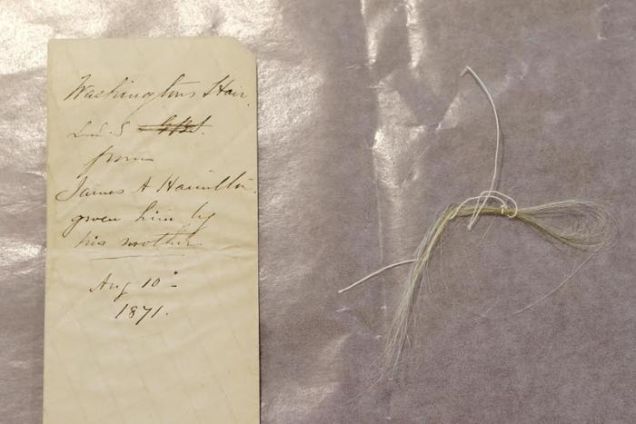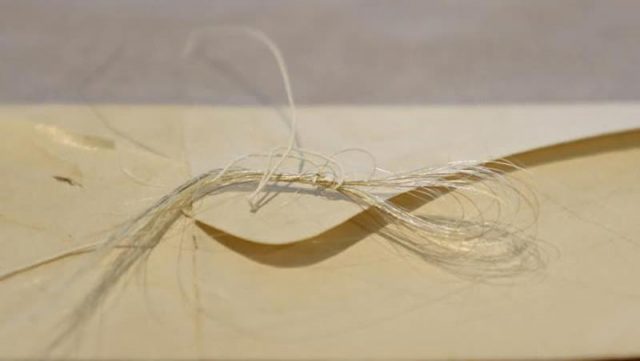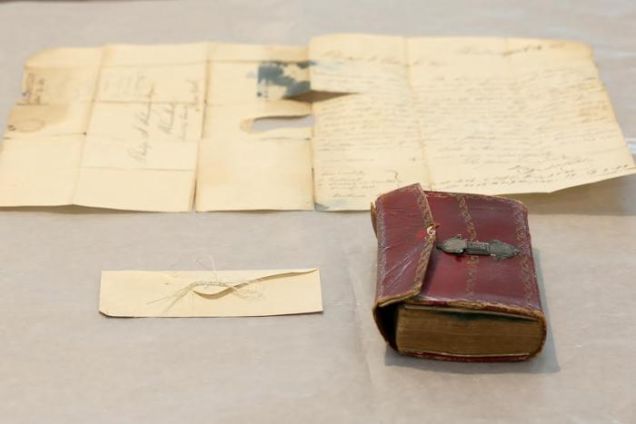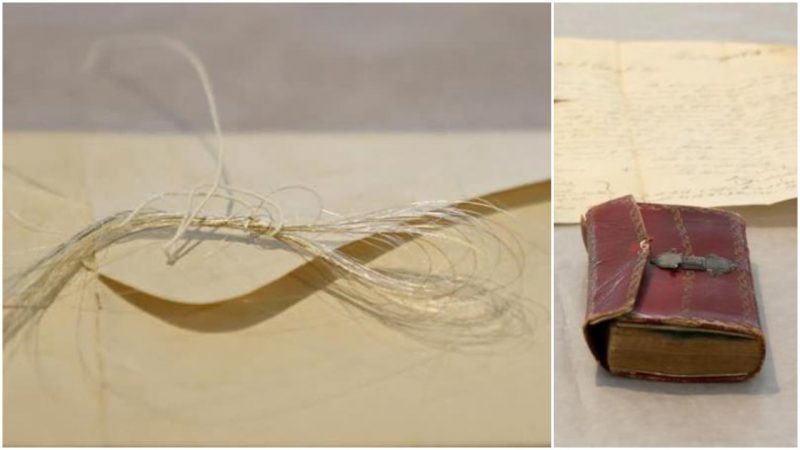It was the kind of task performed in libraries all the time: Catalog and inventory some books which seem to have gone astray. To do so, Daniel Michelson, a historical-records project archivist, was digging through some of the oldest books at the Schaffer Library, part of Union College in Schenectady, New York, when he came across a compact leather almanac, Gaines Universal Register or American and British Kalendar for the Year 1793. It contained such things as comparisons of coins and advice on how to preserve beef in the summer.
When Michelson brought the 18th-century almanac to John Myers, catalogue and metadata librarian, Myers discovered a fragile, yellowed envelope tucked inside it containing something quite special. The envelope was inscribed: “Washington’s hair, L.S.S. & [scratched out] GBS from James A. Hamilton given him by his mother, Aug. 10, 1871,” and sure enough, it contained several strands of gray or whitening hair, neatly tied together by a single thread.
“This is a very significant treasure,” said India Spartz, Union College’s head of Special Collections and Archives. “It’s a tremendous testament to history and our connection to some of the most important historical figures.”
The announcement caused a ripple of excitement across the country, as anything to do with George Washington still does, more than two centuries after America won its revolution. Children are educated on stories of the Father of the Country, art museums are brimming with portraits of Washington, and signs in colonial-era hotels boast, “Washington Slept Here.”

This is not the only snippet of hair from Washington’s head. For example, there’s Fraunces Tavern, the small New York City museum erected at the site where Washington raised a glass to his officers at war’s end, which has the president’s false tooth under glass as well as some strands of his hair. And that’s not the only hair holder. Giving someone a lock of your hair was a common custom in the 18th and 19th centuries, not just as a romantic gesture but as a keepsake from a friend or mentor.
The particular hair in this envelope is believed to have belonged to Philip J. Schuyler, the son of General Philip Schuyler, one of the College’s founders. The elder Schuyler was a close friend of Washington, served under him during the Revolutionary War, and later became a U.S. senator from Albany. During the war, he was replaced as the defender of the Continental forces in the 1777 Saratoga campaign and resigned from the army in 1779. Among his many children was Elizabeth, called Eliza, who married Alexander Hamilton.

Historical novelist Stephanie Dray, the co-author of the upcoming book about Eliza titled My Dear Hamilton, said that during her two years of researching the novel, “I discovered that Philip Schuyler was a far more important founding figure than we’d ever supposed. He was more of a peer to Washington than much more famous figures, and Washington relied upon him implicitly for the management of supplies and intelligence in New York and especially on the all-important Hudson River. Washington’s friendship with Schuyler was long and fruitful and survived the false accusations that led Schuyler to end his military career.”
Said Dray, who with Laura Laura Kamoie co-authored the bestseller America’s First Daughter, said, “Of course, the two men had even more reason to be friendly when Washington’s charming aide-de-camp, Alexander Hamilton, married Philip Schuyler’s daughter Elizabeth.”
The close connections between the Washington, Hamilton, and Schuyler families becomes clear when the history of the book and its envelope is traced. James Alexander Hamilton, whose name is on the envelope, was the third son of Alexander and Eliza Schuyler Hamilton. According to Union College, “Officials with the Schuyler Mansion, a state historic site in Albany, believe that James Hamilton gave the lock of Washington’s hair to his granddaughters, Louisa Lee Schuyler and Georgina Schuyler, whose initials are on the envelope discovered at Union.”

There are many myths about Washington, whose face and hair appear on the dollar bill and the quarter, and one is that he wore a wig. Washington did not wear a wig. His hair was originally reddish-brown and he powdered it to achieve the fashionable white color. By the time of his presidency, however, the reddish-brown had faded to the gray-white color seen in the strands found in February 2018.
The college does not intend to have the hair tested to prove a scientific connection because of fears the procedure would damage the strands.
John Reznikoff, a prominent manuscripts and documents dealer in Westport, Connecticut, examined photographs of Union’s material. “Without DNA, you’re never positive, but I believe it’s 100 percent authentic,” said Reznikoff.
Nancy Bilyeau, the U.S. editor of The Vintage News, has written a trilogy of novels set in the court of Henry VIII: ‘The Crown,’ ‘The Chalice,’ and ‘The Tapestry.’ The books are for sale in the U.S., the U.K., and seven other countries. For more information, go to www.nancybilyeau.com.
